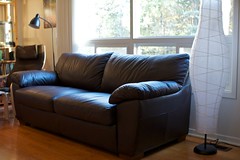

An update on our summer plans to get the apartment into shape, execution of which plans has stretched into the fall.
I bought new shelves for the kitchen in August; they replaced a bunch of increasingly beat-up bookshelves that have since been redistributed to the basement and bedroom. For IKEA geeks, they were Bestå shelves, which are intended for living room entertainment systems, but they adapted well to kitchen use.
Living room upgrades are now done. Last month I splurged and bought a 40-inch LED high-definition TV set and a Blu-Ray player; it’s a profoundly better experience than the old 26-inch standard-def widescreen we’ve been using for the past five years. All old TVs have found new homes in places other than landfills.
Last week the new leather sofa bed showed up, sooner than expected: I ordered it online and it turned up after a week; I’d been led to expect three weeks when I asked at the Ottawa store. Unlike the TV, this was a necessary upgrade: the old futon (which now goes into the basement) was uncomfortable to sit on for long periods of time, and no other sofa bed in my price range, leather or fabric, was as comfortable as this one.
Jen also picked up an Apple TV last Thursday; I’ll have my first impressions of the gadget in a blog entry soon.
HDMI cables, which we needed to connect the Blu-Ray and the Apple TV to the television, are overpriced. It cost me $30 to grab one at Best Buy; I later ordered two more from Monoprice, which arrived in a week and a half and cost me all of $12, shipping included.
The basement is largely done. We’ve sent a lot of old crap to the dump, painted the floor (except for a spot or two) and washed the walls (which got rid of the musty — i.e., mouldy — smell), and put up new shelves. Still some sorting (and a little painting) left, but it’s already an order of magnitude more habitable than it was before.
All these purchases have emptied my bank account (or will when it comes time to pay the credit card bill), but that simply means that I’ve allocated the money I saved up while working on contract for the federal government. This was what it was for, you see.



